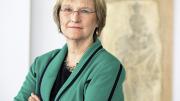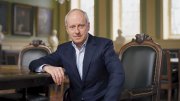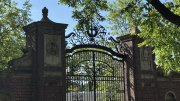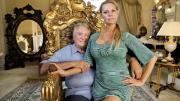There is something to love about every season at Harvard, but, in my mind, autumn is unmatched as a time for new beginnings. Watching eager students crisscross the Yard in swirls of leaves to get to a new class, hearing from faculty about new research collaborations or courses, walking into Massachusetts Hall to escape the chill of early morning and learning about an exciting advance soon to be announced: these are—with due thanks to Rodgers and Hammerstein—a few of my favorite things.
This fall, I was grateful to add another item to that list: exploring the new home of the Harvard Art Museums. After an ambitious six-year renovation and expansion project led by renowned architect Renzo Piano, the Fogg Museum, Busch-Reisinger Museum, and Arthur M. Sackler Museum have been brought together for the first time in new and renewed spaces on Quincy Street. Familiar brick façades intersect with dramatic glass walls and ceilings and wood-clad forms, welcoming all comers from the community into spaces that invite closer and deeper looks. On my first visit, I encountered something arresting around every corner: Max Beckmann’s Self-Portrait in Tuxedo, Winslow Homer’s Pitching Quoits, Vincent van Gogh’s Self-Portrait Dedicated to Paul Gauguin.
Interacting directly with objects that communicate human achievement and history is a moving experience, and the addition of forty percent more exhibition space creates expanded opportunities to share the approximately 250,000 objects in Harvard’s collections. Dedicated galleries give students and scholars of art and art history ample time to study drawings, paintings, sculptures, and other works, and the Art Study Center brings objects not currently on display into view for faculty, students, and visitors. These activities are complemented by the work of specialists in the Straus Center for Conservation and Technical Studies, located on the topmost floors to provide natural light in laboratories and daily views of essential conservation efforts.
For those familiar with the Fogg Museum in its previous state, one of the most striking transformations is the Calderwood Courtyard. The space, its travertine stone painstakingly cleaned and its mortar joints repointed, is filled with light that passes through the building’s glass and steel roof. Galleries and research centers on multiple levels are visible from its center, and one can pass easily through its sixteen portals and move unencumbered to connect with extraordinary—and extraordinarily varied—works of art. Tradition and innovation meet, embodying the potential not just of the arts at Harvard, but of Harvard in a changing world.
Students a century ago needed a “good excuse” to visit Harvard’s holdings, as one Crimson writer put it, because regular courses rarely included “spheres of voluntary culture” such as the Fogg. Today, undergraduates engage fully with the collections across concentrations. Imagine seeking inspiration for an original music composition from a work assigned to you in class, learning introductory Italian by being immersed in the collections with an audio recording to guide you, or studying wood anatomy in an organismic and evolutionary biology course by examining the backs of painting frames. Regardless of field or discipline, students develop an informed sense of seeing and new ways of looking, gaining a deeper understanding of the past and the future in the process.
The arts represent in all their variety the impulse to question and create that has sparked centuries of inquiry and progress at Harvard. They free us from what we thought we understood—what we thought was possible—and challenge us to reconsider our assumptions. The Harvard Art Museums have been brought together in a breathtaking space that invites us to make time for reflection and appreciation, and I am confident they will introduce “favorite things” to countless people for generations to come.
Sincerely,
Drew Faust









